How to Make Swiss Meringue Buttercream (Easy Tutorial)
This is a detailed tutorial on making homemade Swiss meringue buttercream with step-by-step photos and easy-to-understand instructions. Once you make a batch successfully, you may never go back to other types of frostings.
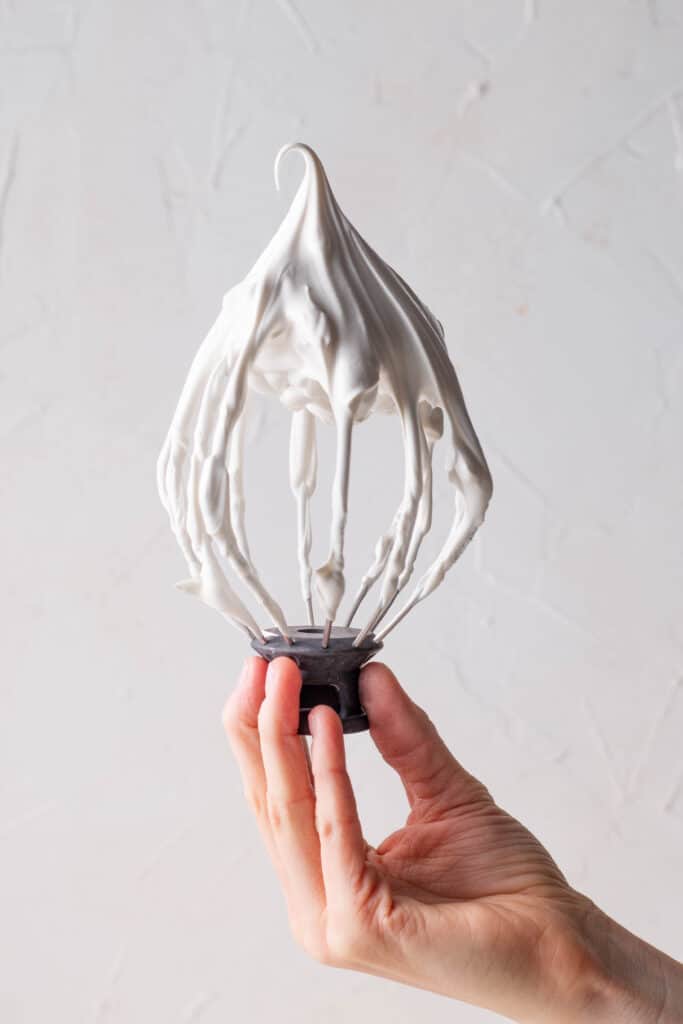
How to Make Swiss Meringue Buttercream
When I first started baking, cream cheese buttercream and American buttercream was the only thing I knew. It was what I gravitated towards naturally because it always seemed like the easiest and best-tasting option. And don’t get me wrong, cream cheese buttercream will still always remain one of my absolute favorite frostings of all time (especially when it’s on these moist pumpkin cupcakes), but there is so much more that the frosting world has to offer.
Enter Swiss meringue buttercream (SMBC). The fluffy, perfectly light, airy, and creamy frosting that will take your boring old cakes or cupcakes to the next level. There’s just something – to put it simply – magical about this buttercream and I think this blog post will help show you why.
I also want to point out that I have discovered just about every way to NOT make SMBC. When I first learned to make this buttercream I had many, many failed attempts and days where I’ve wanted to throw my mixer out the window, which is why I feel so qualified to teach you how to do it properly. And don’t worry, with a little practice I know you’ll nail it!
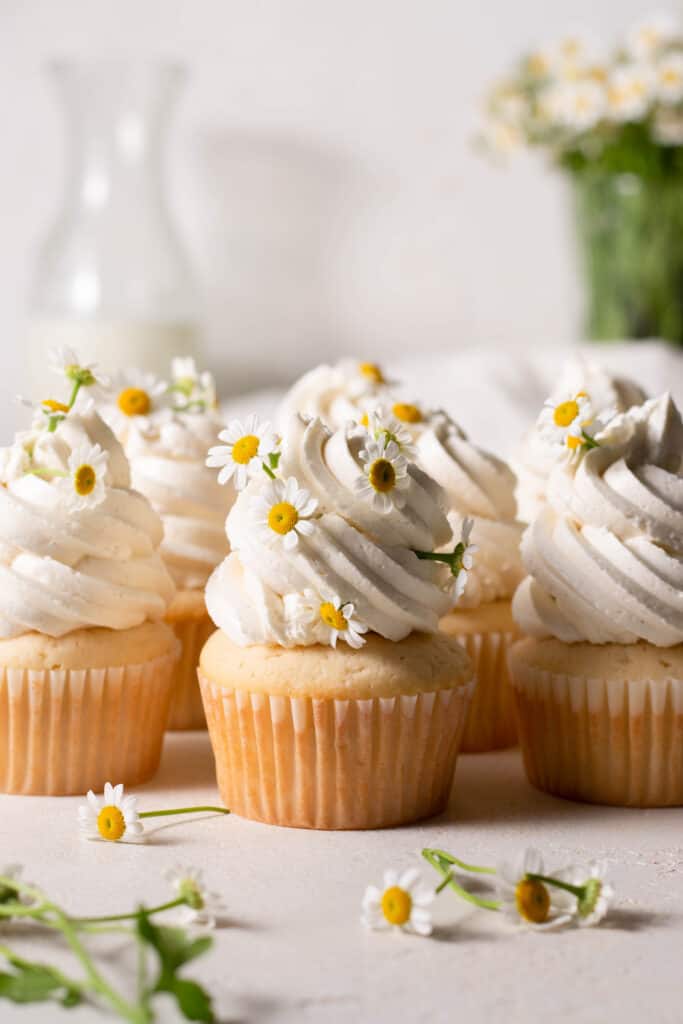
What is Swiss Meringue Buttercream?
There are 2 main European buttercream styles that involve meringues: Swiss and Italian. They’re both known for being very stable (meaning they can withstand heat and movement more easily than others), creamy, and not-to-sweet frostings. Something like American buttercream tends to be overly sweet, so when you’re going for something a little less sweet, one of these 2 are really great alternatives.
Swiss meringue buttercream comes together by cooking egg whites and sugar in a double broiler, beating them until they form stiff peaks, and then slowly incorporating the butter and other flavorings at the end. It’s arguably the easiest of the 2 styles (although I personally think Italian is a little bit easier), and once you get the hang of it I promise you won’t go back. It has a texture that’s unlike any other frosting, and I’m so excited to show you how to make it!
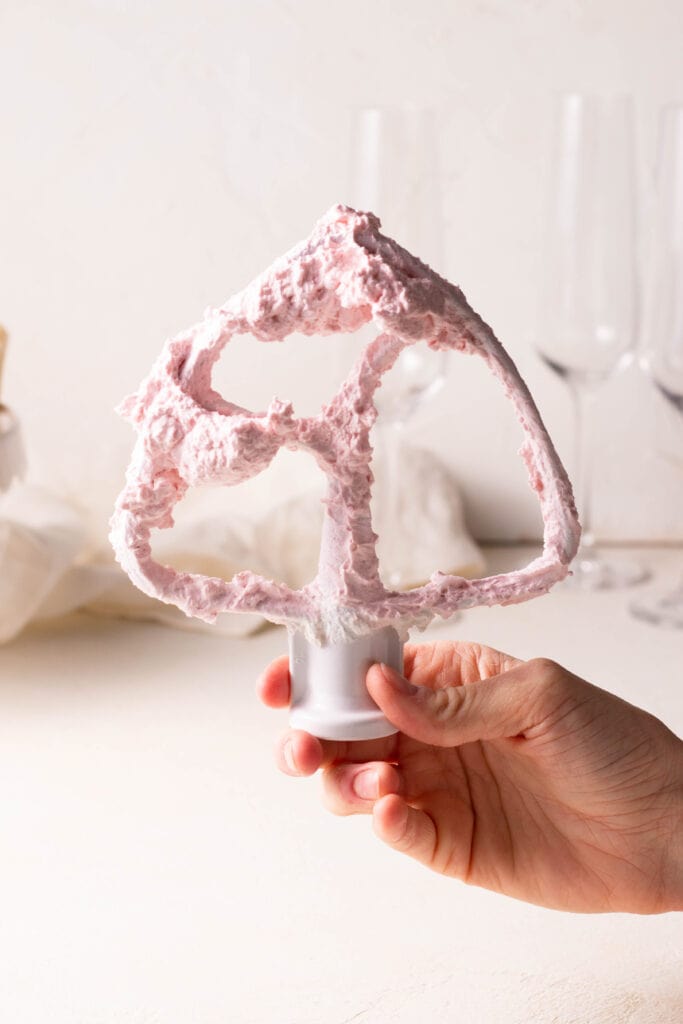
Ingredients for Swiss Meringue Buttercream
The great thing about swiss meringue buttercream is it only has 5 ingredients:
- Egg whites – you’ll need to separate the egg whites from the egg yolks. Quick tip: it’s best to do this while they’re cold. Separating room temperature eggs just never works out the way you want it to.
- Granulated sugar – no powdered sugar or brown sugar here. You’ll need to feel the egg mixture between your fingers to ensure the granules are completely dissolved before you begin beating them, so it’s important to use granulated sugar.
- Unsalted Butter – For this swiss meringue buttercream recipe we really want to control the flavor, and unsalted butter allows us to do that. I will say though, I’ve tested this with salted butter and it turned out fine, but just don’t add any additional salt.
- Vanilla Extract – pure vanilla extract here, folks! Now is not the time for the artificial stuff.
- Kosher salt – I only use diamond crystal kosher salt in my kitchen, so that’s what I always recommend!
Now, let’s get into the how-to….
Easy Guide on Making Swiss Meringue Buttercream
Step 1 – Whisk the egg whites and sugar together in the bowl of a stand mixer or other heat-proof bowl
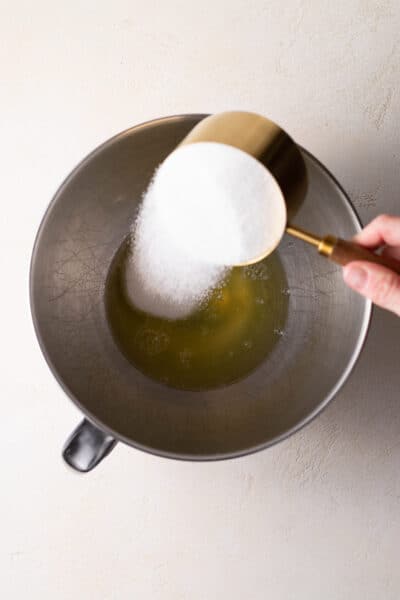
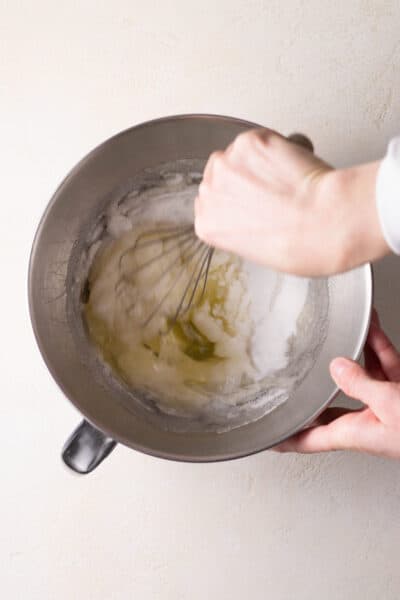
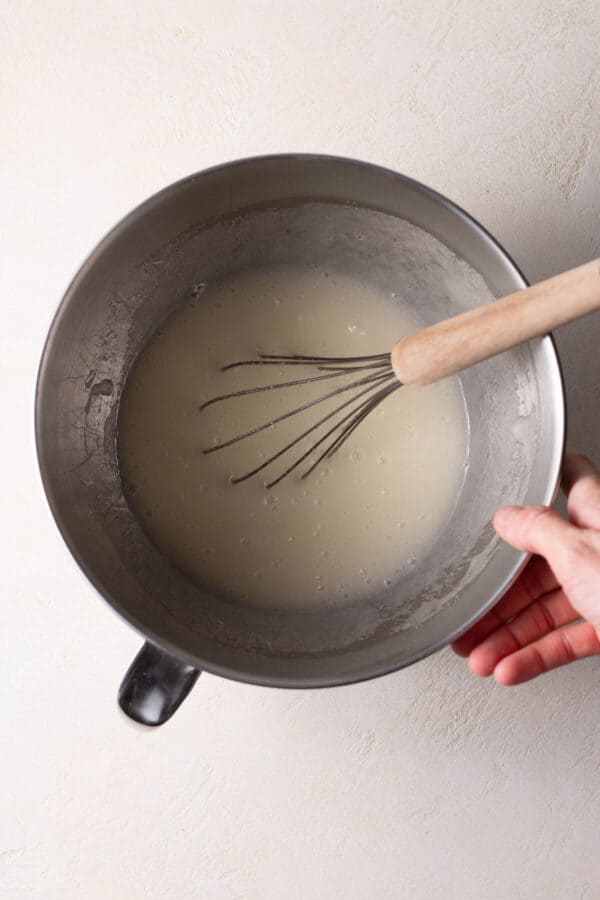
First we’ll need clean our equipment and separate our eggs. If there is any fat residue leftover on the inside of your bowl or on the whisk attachment your meringue won’t set up as it should. I always wipe down my bowl and attachments with a little bit of white vinegar or lemon juice before starting.
To separate your eggs, do so one at a time. An egg yolk also contains fat, so any streak of yolk in the mixture will also cause your meringue to deflate. I recommend separating your eggs into a bowl, and adding 1 white to the bowl at a time. That way, if you accidentally get a yolk in 1 egg white you don’t have to throw the entire thing away.
Next, we’ll whisk the sugar and egg whites together in the bowl of a stand mixer. If you don’t have a stand mixer, just use another heat-proof bowl and you’ll use a hand mixer or whisk (if you’re brave and have strong arms) to beat up the meringue.
I highly recommend using a stand mixer if you have one because the beating process takes longer than you may think. So once we combine these you’ll set the whole bowl over a saucepan with about 2 inches of simmering water in the bottom of it. This will be our mock double-broiler – the perfect way to cook egg whites without making scrambled eggs.
Step 2 – Cook egg mixture until it registers 160°F on an instant-read thermometer
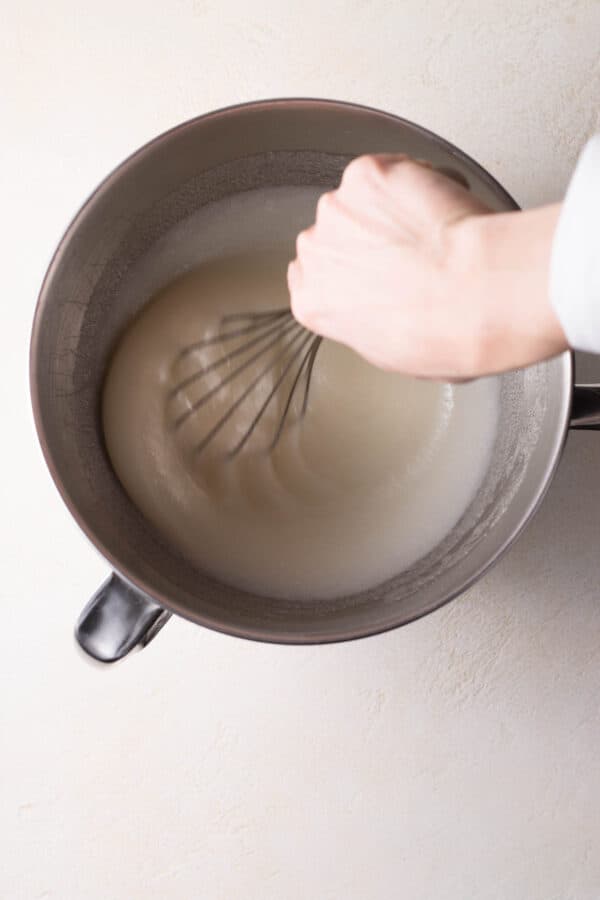
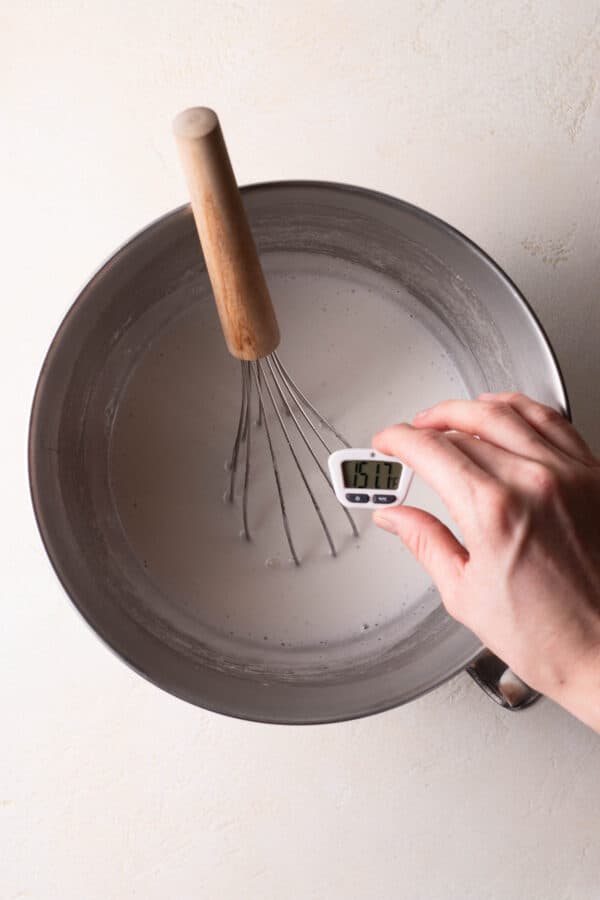
You’ll need to cook your egg mixture, whisking it occasionally, until it reaches 160°F. This is the temperature at which the sugar granules will dissolve into the egg whites. If you’re unsure if they’re fully dissolved though, you can also try this:
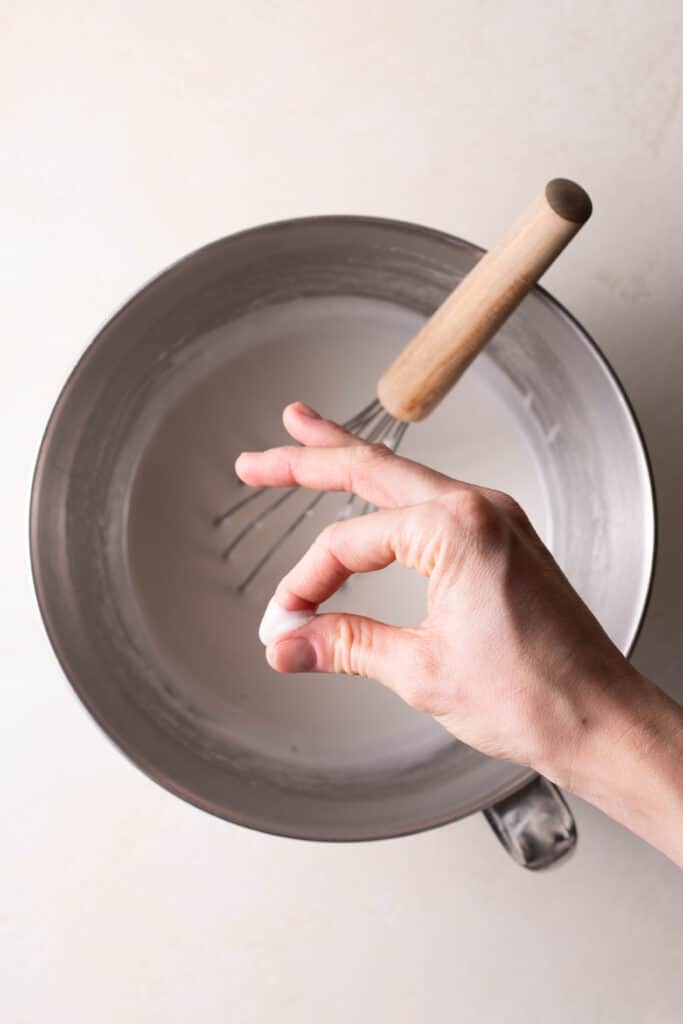
Quickly dip your pointer finger into the mixture and rub it between your fingers. It is a little bit hot so be ready for that! You shouldn’t be able to feel any sharp sugar granules whatsoever. If you don’t, you’re ready for the next step. If you do, continue cooking and whisking until it’s completely smooth.
Step 3 – Whip the egg mixture to stiff peaks
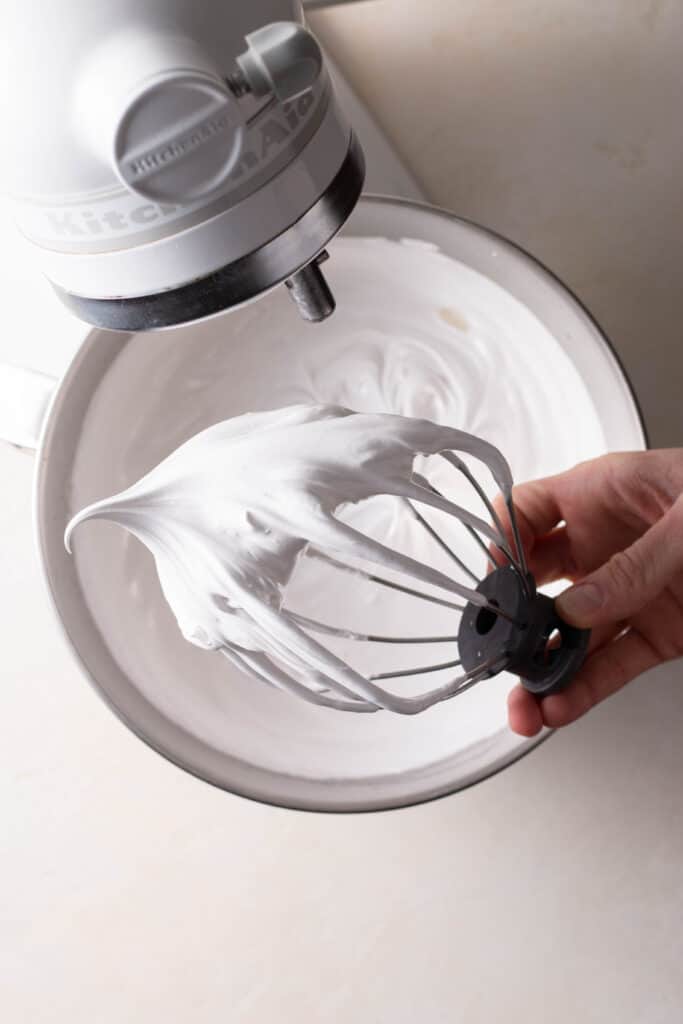
Ok folks, this is where things start to get a little dicey. But if there’s one thing I’ve learned about making swiss meringue buttercream – and just baking in general – it’s that patience is key.
We’re going to begin whipping our egg whites with the whisk attachment in our stand mixer. The goal here is to achieve stiff peaks, cool down the mixture so that you can add butter to it without it melting, all while not overwhipping the meringue.
Here’s a couple tips for this step:
- Whip the meringue on high speed to stiff peaks. Now is not the time for a slow and steady mix. We want to beat lots of air into those whites. Because the egg whites are so warm it can take around 10 minutes to get stiff peaks, but when I made this batch it was a particularly cold, dry day so it realistically only took about 5 to 7 minutes.
- Do NOT over-whip the mixture. I think it’s easy to think that a meringue can’t be over-whipped, but this could not be further from the truth. If you begin to over-whip the whites, the mixture will deflate and you’ll end up with a grainy, loose, and soupy mixture – even before you add the butter! Not what we’re going for. Trust me on this one – I’ve over-whipped a Swiss meringue too many times to count just because I wasn’t paying close enough attention.
- Is it taking too long to achieve stiff peaks? If it’s taking longer than 10 minutes to reach stiff peaks, stop the mixer and place the entire bowl in the refrigerator for 10 minutes exactly. Then, place the bowl back on the mixer and continue whipping. It should help the bowl come to room temperature as well.
Step 4 – Begin adding the butter
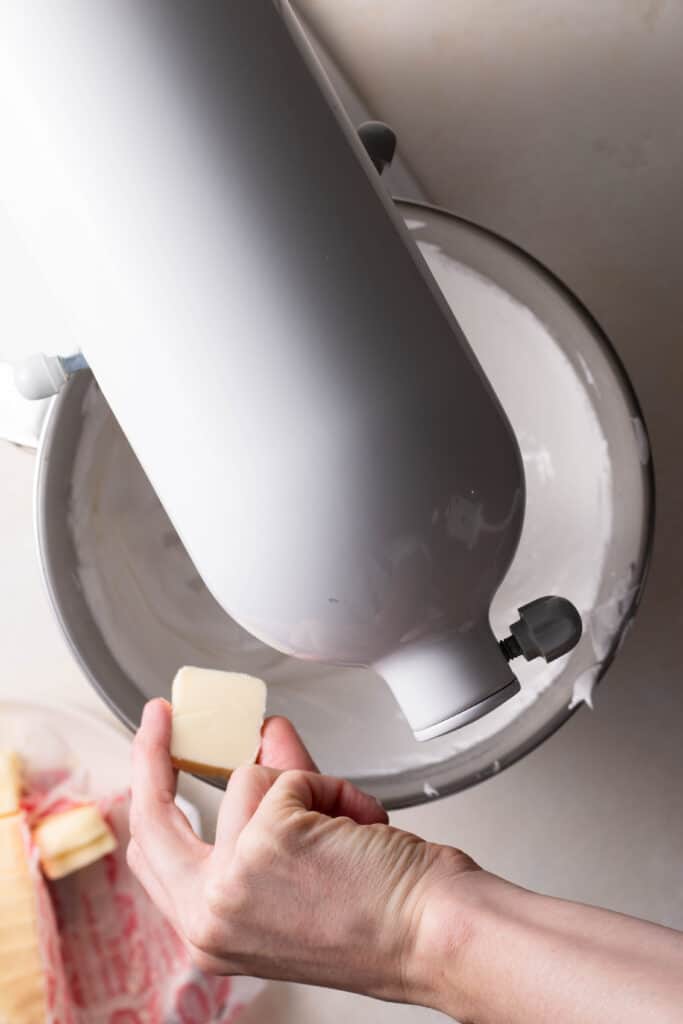
This is when it becomes very important to stay the course and just stick with your buttercream – it will come together! With the mixer running on medium speed, we’re going to add half of the butter 1 Tbsp at a time, waiting until it’s fully incorporated before we add the next Tbsp. Here’s a tip: make sure the meringue and the bowl are close to room temperature before you being adding the butter (feel free to stick the whole bowl in the fridge for a few minutes to help it get there).
Step 5 – Switch to the paddle attachment and continue beating in remaining the butter
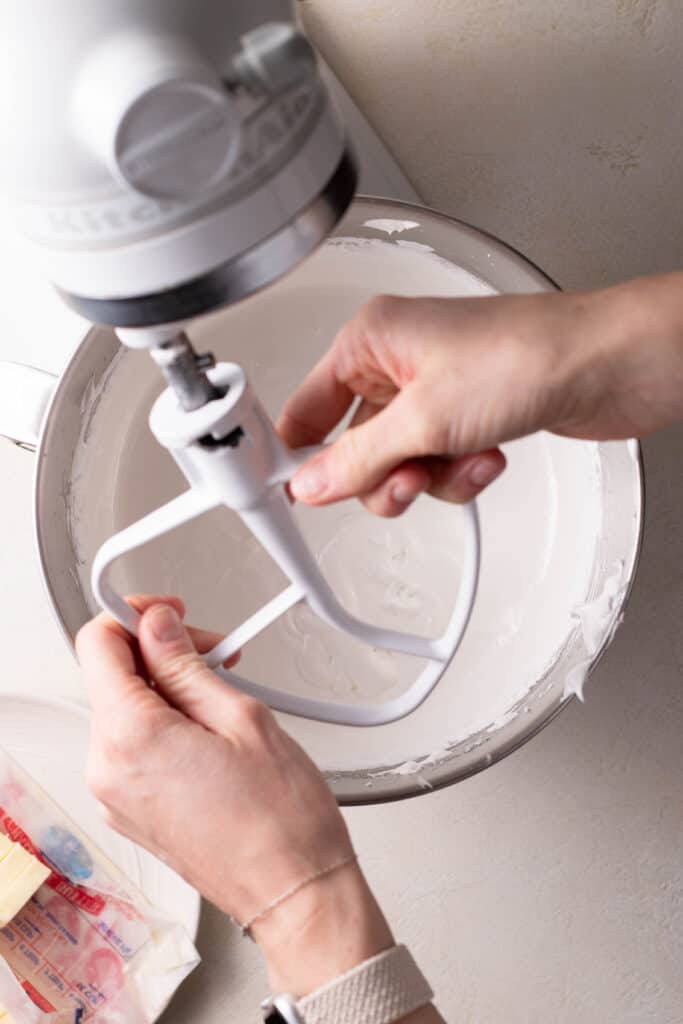
Once you’ve added half of your butter with the whisk attachment we’re going to switch to our paddle attachment because this will help smooth everything out for the remaining half of our butter.
Troubleshooting swiss meringue buttercream
Now, there are 3 things that could happen during this step:
- Your buttercream comes together in a smooth, perfect consistency. Congrats!! You did it!! It doesn’t happen too often where you get to the perfect consistency on the first go round, but yay if you did!! Now you can add your flavorings.
How to fix curdled swiss meringue buttercream
The second thing that could happen during this step is your buttercream turns into a curdled mess.
Sadly, the SMBC may have separated and the result is small flecks of butter that look slightly chunky and thick. The butter may have been colder than the meringue when you began beating it.
How to fix:
Remember our saucepan of simmering water in the beginning? Bring that water back to a simmer and place the bowl over the water. Let it sit, without mixing, for 1 to 2 minutes or until the edges of the meringue warm up and become liquid. Then, transfer the bowl back to the mixer and beat on low speed for 30 seconds, then medium-high speed until it becomes smooth (usually about 1 to 2 minutes). This should solve the problem and will actually result in an even creamier buttercream!
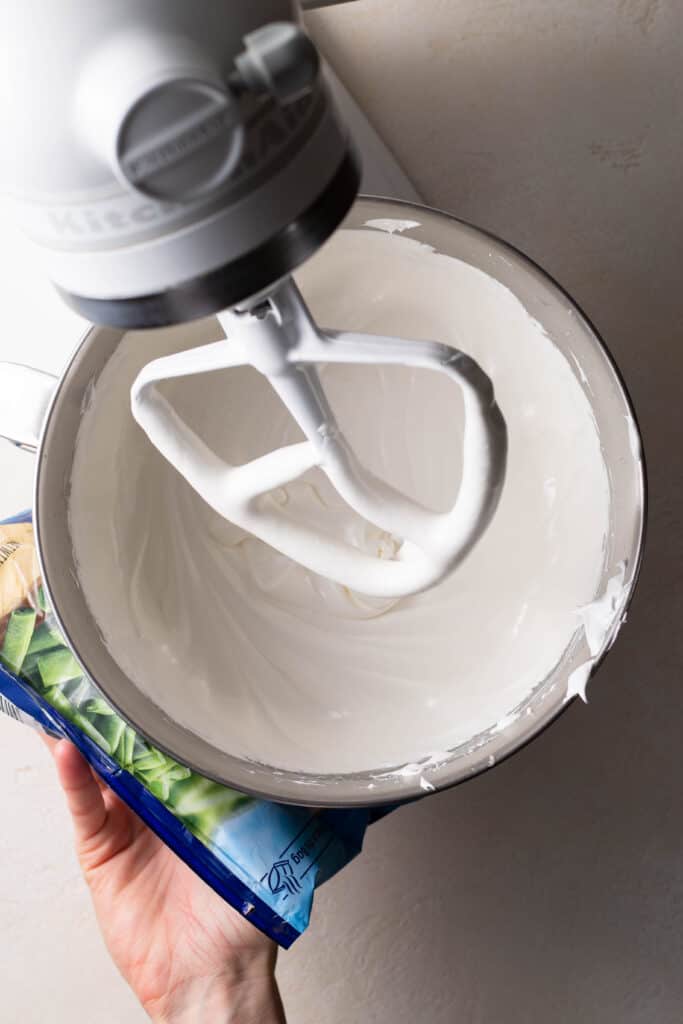
How to fix soupy swiss meringue buttercream
The second thing that could happen during this step is your buttercream turns into soup.
Unfortunately, your butter may have become too soft in the meringue when you added it, resulting in a warm SMBC. This is what happens to me about 75% of the time – you can see what it looks like in the image below – and there’s also a simple fix for this as well.
How to fix:
Simply take a bag of frozen peas (or whatever you have in your freezer – in my case green beans), and hold it on the sides of the bowl while it’s mixing on low speed. After holding it here for a few minutes the mixture should cool off and begin to thicken. But, if it’s still not thickening, place the entire bowl in the refrigerator in 20 minute spurts. Then, place the bowl back on the mixer and beat on high speed until it thickens up, about 1 to 2 minutes.

This is where patience comes in. And its so important to trust in what you’re doing – it’ll come together even if you need to troubleshoot a little bit.
Step 6 – Light, creamy, and fluffy Swiss meringue buttercream!
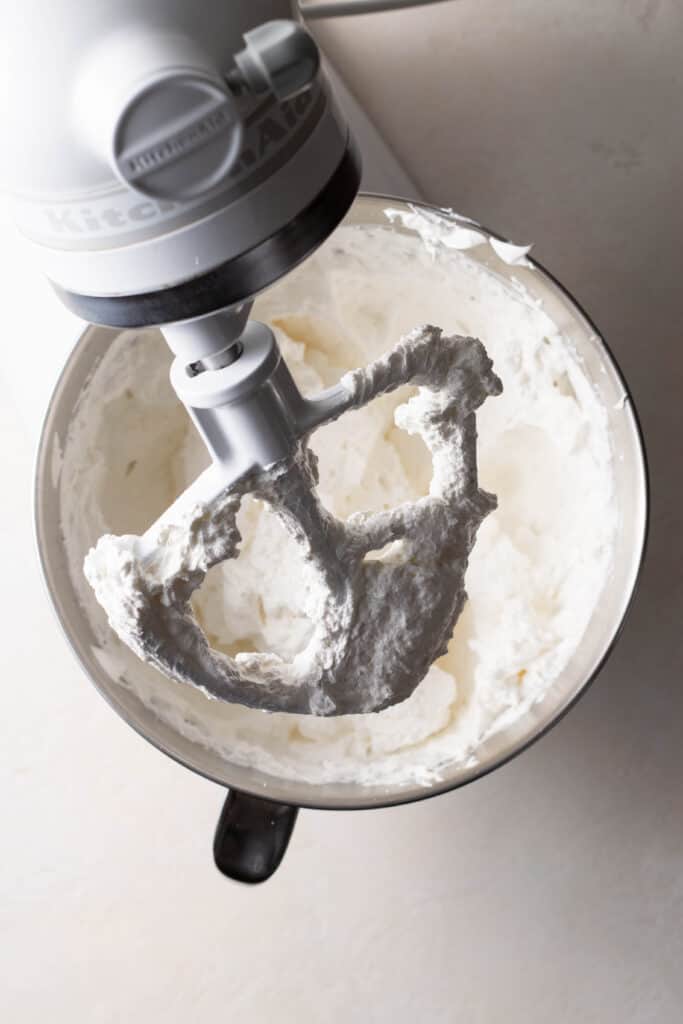
Yay!! you now have perfect buttercream ready for your cakes and cupcakes. You’ll be amazed at how light and creamy it is – and it pipes like a dream!
Step 7 – Add your flavorings
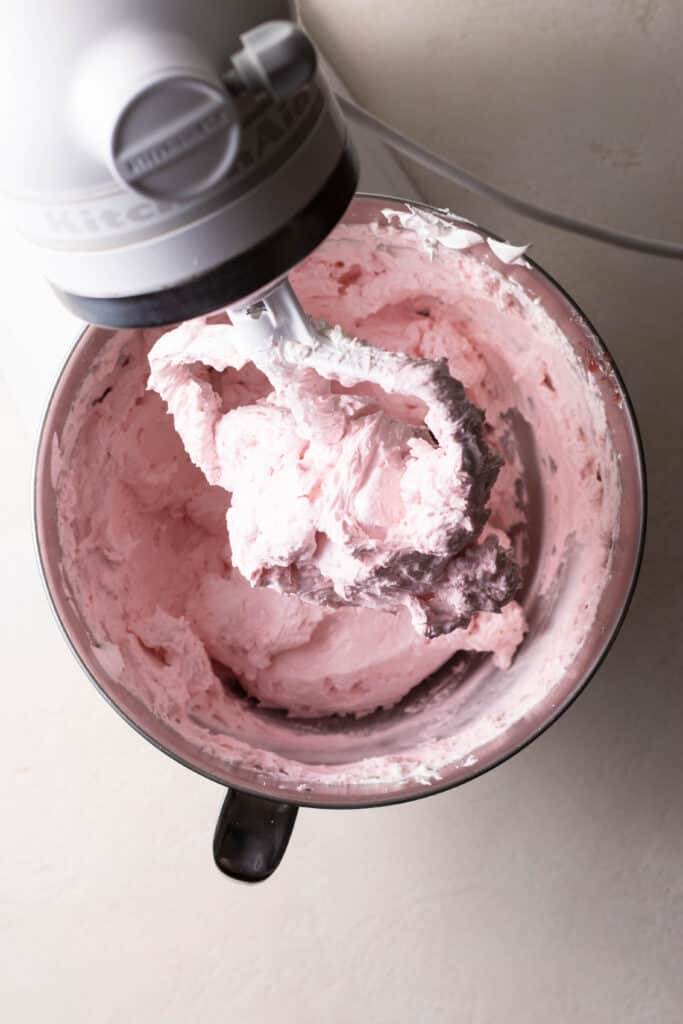
For this specific batch I was making a strawberry swiss meringue buttercream, so I added about 1/2 cup fresh strawberry jam, a little bit of vanilla, and some salt. I also added some red food coloring to make it pink!! Quick tip: always use a gel food coloring as it doesn’t contain as much liquid. We want to keep our liquid additions to a minimum, so these are the best options.
Hopefully you all will have your perfect swiss meringue buttercream moment with the help of this blog post. I remember the first time I made it successfully, I ran upstairs to tell Noah and we both celebrated. I was celebrating because I finally had done it, and Noah was celebrating because I didn’t waste -yet another- pound of butter lol. Louie was also celebrating because he obviously wanted to lick the beater….
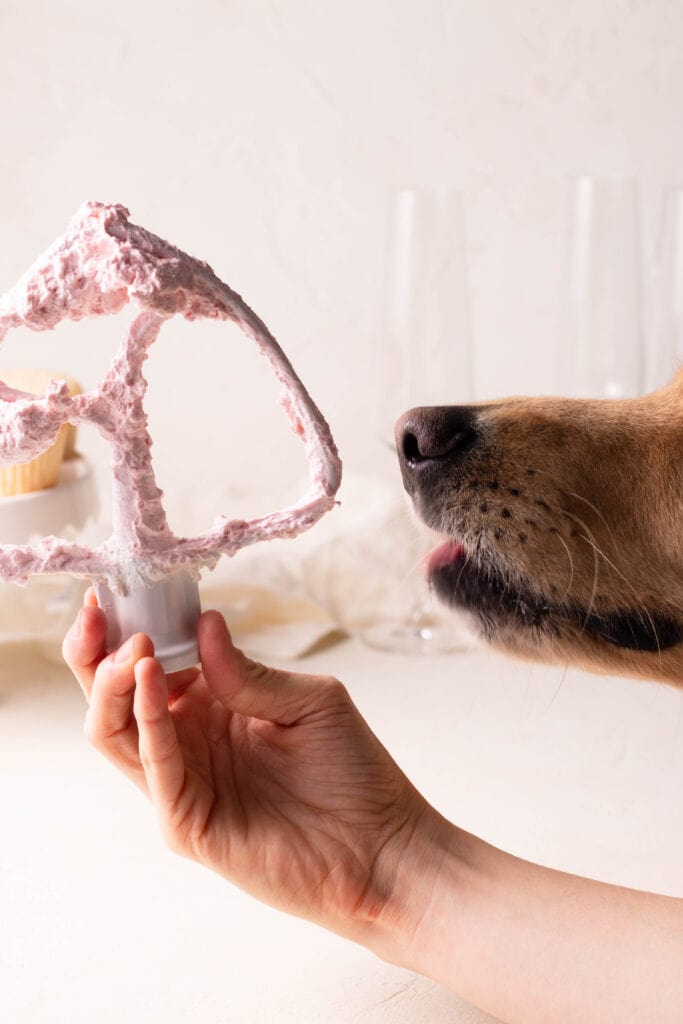
I hope this post has been helpful for you, and if you make a batch please please please tag me on socials (@sarahsdayoff) so I can celebrate with you!!!
Love,
Sarah
Swiss Meringue Buttercream
Ingredients
- 6 large egg whites
- 2 cups granulated sugar
- 1 1/2 cups (3 sticks) unsalted butter softened to about 63°F and cut into Tbsp sized pieces
- 2 tsp pure vanilla extract
- 1/8 tsp kosher salt
Instructions
- First, read the above blog post for a detailed step-by-step tutorial, this will help you in the long run I promise!
- Whisk egg whites and sugar in the the clean bowl of a stand mixer (or another heat-proof bowl) and set over a saucepan with 2 inches of simmering water on medium heat.
- Cook egg mixture, stirring occasionally, 5 to 7 minutes or until mixture registers 160°F on an instant-read thermometer and sugar granules are completely dissolved. To test if the sugar is completely dissolved, quickly dip a finger into the mixture and rub between your fingers. It should be completely smooth.
- Transfer bowl to a stand mixer fitted with the whisk attachment and beat on high speed until stiff peaks form, about 7 to 10 minutes. If you hit 10 minutes and still don't have stiff peaks, place the entire bowl in the refrigerator for exactly 10 minutes. Then, remove the bowl and continue beating until stiff peaks form.
- Once you reach stiff peaks, if the bowl and meringue are still warm to the touch, refrigerate for 10 minutes exactly and proceed to the next step.
- With the mixer running on medium-low speed, beat in half of the butter (3/4 cup or 1 1/2 sticks), 1 Tbsp at a time, waiting until 1 Tbsp is completely incorporated before adding the next.
- Switch to the paddle attachment and continue beating in remaining butter on medium-low speed, still adding it 1 Tbsp at a time until buttercream is smooth, fluffy, and holds its shape.
- Beat in vanilla and salt.
- If the buttercream is curdled: Sadly, the SMBC may have separated and the result is small flecks of butter that look slightly chunky and thick. The butter may have been colder than the meringue when you began beating it, so here's a super quick fix: remember our saucepan of simmering water in the beginning? Bring that water back to a simmer and place the bowl over the water. Let it sit, without mixing, for 1 to 2 minutes or until the edges of the meringue warm up and become liquid. Then, transfer the bowl back to the mixer and beat on low speed for 30 seconds, then medium-high speed until it becomes smooth (usually about 1 to 2 minutes).
- If the buttercream is soupy: Unfortunately, your butter may have become too soft in the meringue when you added it, resulting in a warm SMBC. Simply take a bag of frozen peas (or whatever you have in your freezer) and hold it on the sides of the bowl while it's mixing on low speed. After holding it here for a few minutes the mixture should cool off and begin to thicken. BUT, if it's still not thickening, place the entire bowl in the refrigerator in 20 minute spurts. Then, place the bowl back on the mixer and beat on high speed until it thickens up, about 1 to 2 minutes.
Notes
This post contains affiliate links which may make me a small commission at no cost to you. Thank you for supporting Sarah’s Day Off!




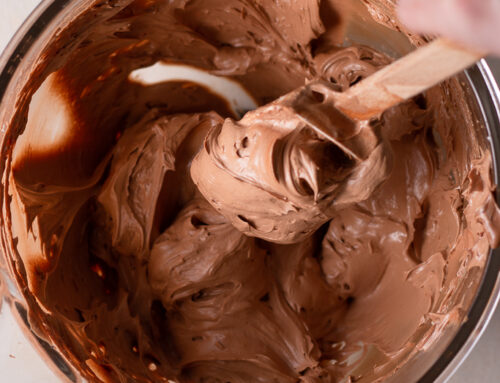
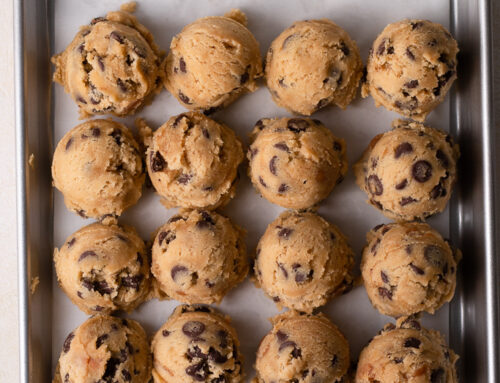
These instructions finally helped me perfect this! I love the pic with your dog in it!! 🙂
Thanks Martha! I love sneaking Louie into the shoots wherever I can 🙂
[…] thermometers are great for lots of different things, I use mine a lot for Swiss Meringue Buttercream, French Buttercream, and Homemade […]
What about Meringue powder that I hear so much of???
That is something commonly used to make royal icing, but it’s not necessary in this recipe! As long as you keep your tools and bowl really clean, the meringue will whip up no problem.
[…] or months, having a stand mixer will help tremendously! Especially when making something like swiss meringue buttercream or homemade […]